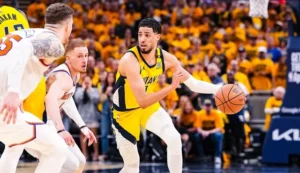Introduction to the Pacers vs Knicks Matchup
The rivalry between the Indiana Pacers and the New York Knicks is steeped in history and has garnered significant attention in the world of basketball. This longstanding confrontation has typically taken center stage in the NBA, characterized by intense competition and memorable moments that resonate with fans across the league. The Pacers and Knicks have faced off numerous times, often in high-stakes games that have implications for playoff positioning and team morale.
Throughout the years, both teams have displayed a unique blend of styles, making each encounter a showcase of contrasting strategies and player capabilities. As the teams prepare for their upcoming matchup, the significance of the game extends beyond the win-loss record. It serves as an opportunity for both franchises to assert their dominance within the Eastern Conference. Current context, team form, and player health have all become focal points leading up to this anticipated showdown, further intensifying the matchup’s importance.
The trajectory of both teams has seen its ups and downs, illustrated through fluctuating player performances and injury concerns. The recent form of key players will play a crucial role in determining the outcome, and the player stats from the most recent games offer insights into how each team has been faring. Monitoring the health of star players and understanding the dynamics of the roster will be essential as fans analyze the upcoming Pacers vs Knicks match. These elements combine to create a riveting narrative that sets the stage for an enthralling encounter, rich with implications for the rest of the NBA season.
Top Performers: Key Player Stats from the Game
In the highly anticipated Pacers vs Knicks match, individual performances played a significant role in determining the outcome of the game. Evaluating key player statistics, we see contributions in scoring, assists, rebounds, and defensive efforts that were crucial for their respective teams. For the Pacers, forward Domantas Sabonis showcased his all-around game, recording 28 points, 10 rebounds, and 8 assists. His efficiency from the floor, along with a presence on both ends, underscores his vital role in the team’s strategy. Comparatively, Sabonis’ scoring significantly exceeded his season average of 22 points per game, indicating a critical performance in a high-stakes matchup.
On the Knicks’ side, Julius Randle had a noteworthy impact, finishing the game with 25 points, 12 rebounds, and an impressive 6 assists. Randle’s ability to facilitate plays while also being a scoring threat demonstrates the versatility that is often needed in such competitive games. His statistics are particularly striking when contrasted with previous matchups where he struggled to find similar offensive efficiency. Moreover, his defensive efforts were essential in containing the Pacers’ perimeter shooting, a key factor in the defensive strategy employed by the Knicks throughout the game.
Additionally, it is worth noting the contributions from the supporting cast. For instance, the Pacers’ Malcolm Brogdon added 18 points alongside 5 rebounds, while Knicks guard Evan Fournier chipped in with 20 points, providing essential scoring depth for each team. The combination of these player stats not only highlights individual talents but also reflects larger trends in team play, such as ball movement and defensive assignments, which were pivotal in navigating the Pacers vs Knicks match. As the season progresses, these performances may signal shifts in consistency and team identity for both franchises.
Comparative Analysis: Team Stats Breakdown
In assessing the performance of the Indiana Pacers and New York Knicks, it is imperative to examine their overall team statistics during the recent match. These metrics provide a foundational understanding of how each team executed their strategies and where potential weaknesses may have been exposed. Key indicators of team performance in the Pacers vs Knicks match player stats include field goal percentage, three-point shooting efficiency, free throw conversion rates, and overall defensive effectiveness.

The Pacers displayed a commendable field goal percentage of 48%, showcasing their ability to convert scoring opportunities. In contrast, the Knicks managed a field goal percentage of 44%, illustrating some difficulty in finishing their plays. Furthermore, when looking at three-point shooting, the Pacers excelled by hitting 37% of their attempts, while the Knicks lagged behind at 32%. This discrepancy in long-range shooting could significantly influence the tempo and style of play, emphasizing the Pacers’ dominance beyond the arc.
Free throw performance is another pivotal component in the matchup analysis. The Pacers managed to convert 80% of their free throw attempts, illustrating their proficiency in capitalizing on fouls. On the other hand, the Knicks struggled somewhat, with only 72% success at the line, which may have affected their ability to close the gap during critical moments of the game.
Defensively, the Pacers demonstrated an impressive defensive efficiency, allowing only 105 points, while the Knicks allowed 112 points. This efficiency not only reflects the ability to contain scoring opportunities but also indicates how well the Pacers executed their game plan. By examining these Pacers vs Knicks match player stats, one can trace patterns from previous encounters between the teams, which often reveal shifting play styles and strategic adjustments over time.
Conclusion: Insights and Implications for Future Matches
The comprehensive analysis of the Pacers vs Knicks match player stats reveals substantial insights that can influence both teams moving forward. Through evaluating individual performances alongside aggregate statistics, it becomes evident that each team showcased specific strengths and weaknesses that could significantly impact their future encounters. The Pacers demonstrated commendable offensive efficiency, particularly from their key players, whose contributions were pivotal in establishing momentum during the game. In contrast, the Knicks exhibited defensive resilience, showcasing their ability to contain significant threats, although lapses in concentration at critical moments ultimately affected their performance.
Moreover, analyzing the pace and dynamic playstyles of both teams illustrated distinct strategies: the Pacers relied on fast breaks and three-point shooting while the Knicks preferred a more deliberate approach centered around post-play and mid-range proficiency. These tendencies, reflected in their respective match player stats, suggest that both teams may need to adjust their tactics based on upcoming opponents. The Pacers might benefit from enhancing their perimeter defense to counter rival teams with sharpshooters, whereas the Knicks could focus on improving their offensive flow to integrate their scoring options more effectively.
Looking ahead, trends identified in the stats from the Pacers vs Knicks matches indicate that each franchise has areas requiring attention and development. For the Pacers to maintain their competitive edge, nurturing their offensive cohesion while bolstering defensive strategies will be essential. Meanwhile, the Knicks will need to further hone their adaptability and in-game adjustments to increase their chances for success in tight matchups. As the season progresses, the statistics from this game will be vital in guiding both teams’ strategies as they vie for dominance in future games.
May Be You Also Read

